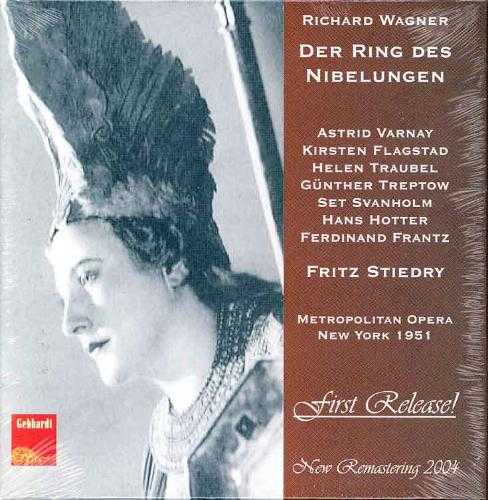
Composer: Richard Wagner
Orchestra: Orchestra of the Metropolitain Opera House
Conductor: Fritz Stiedry
Audio CD
Number of Discs: 11
Format: FLAC (image+cue)
Label: Gebhardt
Size: 1.3 GB
Recovery: +3%
Scan: yes
Das Rheingold CD 01-02
Wotan – Hans Hotter
Fricka – Margaret Harshaw
Alberich – Lawrence Davidson
Loge – Set Svanholm
Erda – Karin Branzell
Fasolt – Jerome Hines
Fafner – Dezso Ernster
Freia – Jarmila Novotna
Froh – Brian Sullivan
Donner – Osie Hawkins
Mime – Leslie Chabay
Woglinde – Erna Berger
Wellgunde – Lucine Amara
Flosshilde – Hertha Glaz
Conductor – Fritz Stiedry
Metropolitan Opera House
January 27, 1951 Matinee Broadcast
Die Walkure CD 03-05
Brunhilde – Kirsten Flagstad
Siegmund – Guther Treptow
Sieglinde – Astrid Varnay
Wotan – Ferdinand Frantz
Fricka – Blanche Thebom
Hunding – Luben Vichey
Gerhilde – Thelma Votipka
Grimgerde – Martha Lipton
Helmwige – Regina Resnik
Ortlinde – Irene Jessner
Rossweisse – Lucielle Browning
Schwertleite – Jean Madeira
Siegrune – Hertha Glaz
Waltraute – Jeanne Palmer
Conductor – Fritz Stiedry
Metropolitan Opera House
February 3, 1951 Matinee Broadcast
Siegfried CD 06-08
Siegfried – Set Svanholm
Brunhilde – Helen Traubel
Wanderer – Ferdinand Frantz
Erda – Karin Branzell
Mime – Peter Klein
Alberich – Gerhard Pechner
Fafner – Dezso Ernster
Forest Bird – Erna Berger
Conductor – Fritz Stiedry
Metropolitan Opera House
February 10, 1951 Matinee Broadcast
Gotterdammerung CD 09-11
Bruhilde – Helen Traubel
Siegfried – Set Svanholm
Gunther – Herbert Janssen
Gutrune – Regina Resnik
Hagen – Dezso Ernster
Waltraute – Margaret Harshaw
Alberich – Gerhard Pechner
First Norn – Jean Madeira
Second Norn – Martha Lipton
Third Norn – Margaret Harshaw
Woglinde – Erna Berger
Wellgunde – Lucine Amara
Flosshilde – Hertha Glaz
Vassal – Emery Darcy
Vassal – Clifford Harvuot
Conductor – Fritz Stiedry
Metropolitan Opera House
February 17, 1951 Matinee Broadcast
stiedry_wagner_der_ring_des_nibelungen1951_02.rar – 128.1 MB
stiedry_wagner_der_ring_des_nibelungen1951_03.rar – 95.9 MB
stiedry_wagner_der_ring_des_nibelungen1951_04.rar – 124.7 MB
stiedry_wagner_der_ring_des_nibelungen1951_05.rar – 96.9 MB
stiedry_wagner_der_ring_des_nibelungen1951_06.rar – 136.5 MB
stiedry_wagner_der_ring_des_nibelungen1951_07.rar – 114.8 MB
stiedry_wagner_der_ring_des_nibelungen1951_08.rar – 129.1 MB
stiedry_wagner_der_ring_des_nibelungen1951_09.rar – 146.3 MB
stiedry_wagner_der_ring_des_nibelungen1951_10.rar – 140.5 MB
stiedry_wagner_der_ring_des_nibelungen1951_11.rar – 125.0 MB
KNAPPERTSBUSCH BAYREUTH 1956: THIS IS THE @RING@ I HAVE ALWAYS WANTED
After living, at one time or another, with the Furtwanlger/Rome, Furtwangler/La scala, and Krauss Bayreuth RINGS, THIS is the complimentary “bookend” RING to the Solti I have long hoped for. From that first, subterranean E-flat pedal to the moment Brunnhilde and Grane leap into the pyre, THIS is the consistently best performed, complete Old School RING. In the present Orfeo transfer, the mono sound is fantastic (not perfect, mind, you, merely fantastic).
Varnay’s Brunnhilde is stupendous; she may scoop a bit, sometimes, but out of stylistic conception – not out of any vocal inadequacy ! Hotter is at his peak as Wotan (apparently, his famous summertime ragweed allergy bothered him less in 1956 than in other years), and his interpretation cuts even deeper than it did, three years earlier, under Krauss; Windgassen is as NATURAL as Siegmund as he is as Siegfried…so much so that one wonders why he told John Culshaw that he never cared much for the role (maybe he tired of it, later). Greindl’s Hagen goes a little hoarse, sometimes, but this IS a live performance, after all, and Hagen isn’t exactly a BEL CANTO role. The Sieglinde, Gre Brouwenstijn, projects such vocal and histrionic strength, that one feels she could EASILY have sung Brunhilde ! The orchestra is excellent throughout, in fact BETTER than under Krauss in ’53, and Bohm in ’66-67; only very occasionally does the brass intonation go sharp. And only in the last incarnation of Siegfried’s horn calls in GOTTERDAMMERUNG – just before that deadly “picnic” on the Rhine – are there any “clams.” It is also true that occasionally, the Bayreuth “cowl” subdues some wind instrument lines, which the experienced ear must “tease out” of the orchestral texture (e.g., the oboe passage in RHEINGOLD, where Fasolt pines for womanly companionship). Basically, these are little things for which Walter Legge or John Culshaw would demand retakes, had this been a studio recording. (The extensive liner notes do not reveal if rehearsal “takes” were used here, or even available). In any case, regardless of what some have written about Kna’s 1957 & ’58 Bayreuth RINGS, and despite the wives tale that Kna “didn’t rehearse,” this 1956 RING does NOT sound unrehearsed. Everyone (but everyone) is on the same conceptual “page”, as Kna conjures a primeval, rich, Old World sound out of the assembled Bayreuth orchestra…It’s the sound one longs for, in vain, from either of Furtwangler’s Italian RINGS, in spite of Furtwangler’s irreplaceable insights. Yes, there are occasional, little time lapses between singer and orchestra, but nothing out of the ordinary for being “live,” and NOTHING like 1) the chronic off-stage choral mismatches with the orchestra in the 1951 PARSIFAL, or 2) the Notung-forging scene in the 1953 Krauss SIEGFRIED (which, even by “live” standards is, rhythmically speaking, a multi-clustered catastrophe).
Finally, Kna’s tempi are NOT “sluggish” – even if generally slower than Krauss’s and Solti’s. They are all wisely and cunningly chosen for overall emotional AND structural effect – even if some might wish for a more impetuous under-girding for Siegmund and Sieglinde in DIE WALKURE, Act I, Scene 3 (which IS provided more in Kna’s ’58 performance). Slower doesn’t
necessarily mean “limp,” as anyone knows who has appreciated any of Kna’s better PARSIFALS.
Additionally, one remembers Maurice Rosengarten’s comment to John Culshaw that “In those [early postwar] days, one thought first of Knappertsbusch in connection with the RING,” as opposed to Solti…Acquire this set, and find out why !Given Kna’s innate genius and irreplaceably unique way with Wagner, and given that his Wagnerian lineage extends back to Hans Richter and Siegfried Wagner himself, we are fortunate to have superbly transferred live versions from him of the Wagner “canon” (except for TANNHAUSER). Among these, certainly the 1955 FLIEGENDER HOLLANDER, 1956 RING and 1964 PARSIFAL (see my review) belong in ANY basic Wagner collection. And as I stated earlier, if you want the best contrasting “bookend” to the Solti (which remains perhaps the best, complete introduction to the RING), look no further.
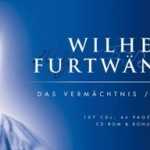
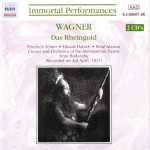
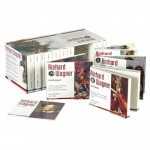
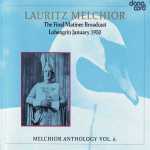
Whatever, thank you. You are an inexhaustible fountain of good MUSIC.
Great and rare :) Thank you very much !!!!
I seem to have missed this one, luckily you did not. Thank you, also especially for providing full scans lately.